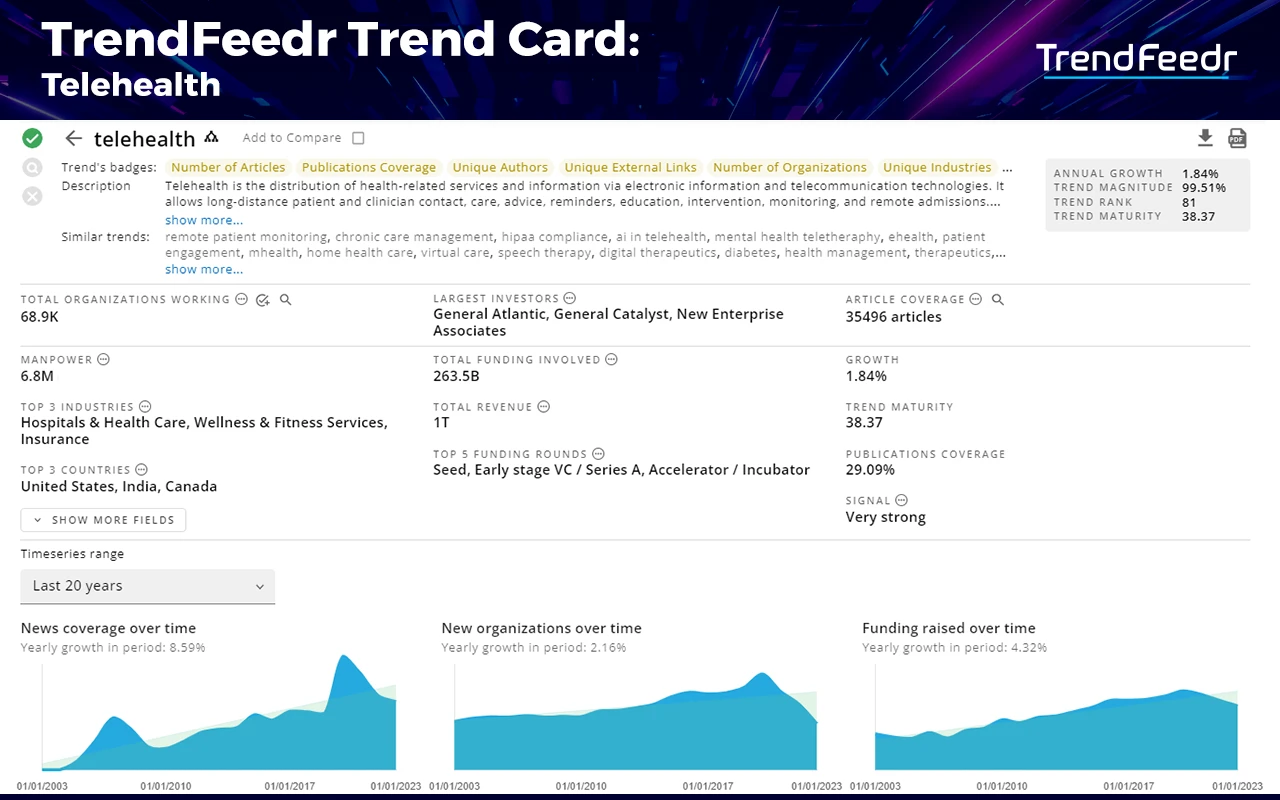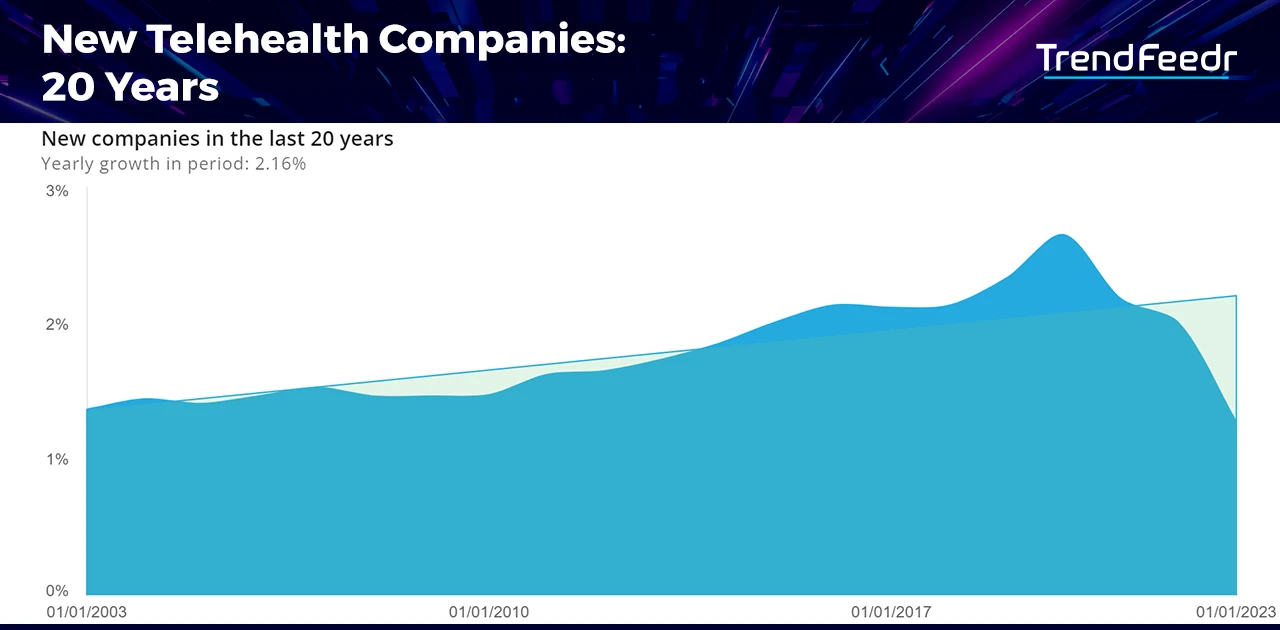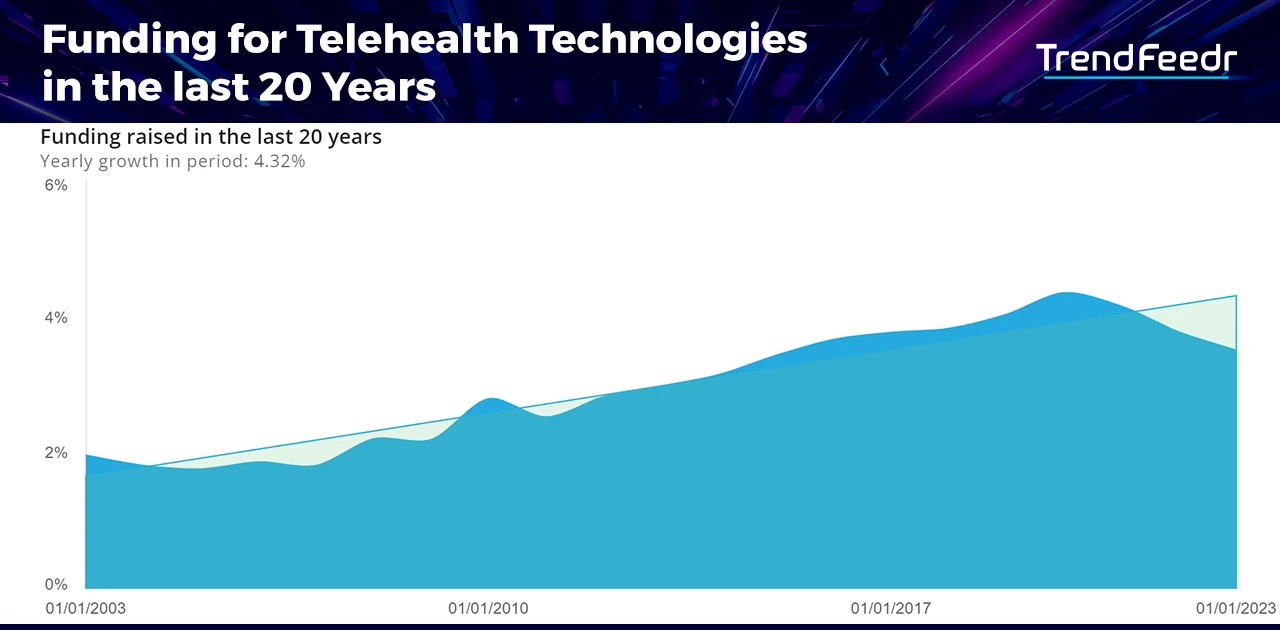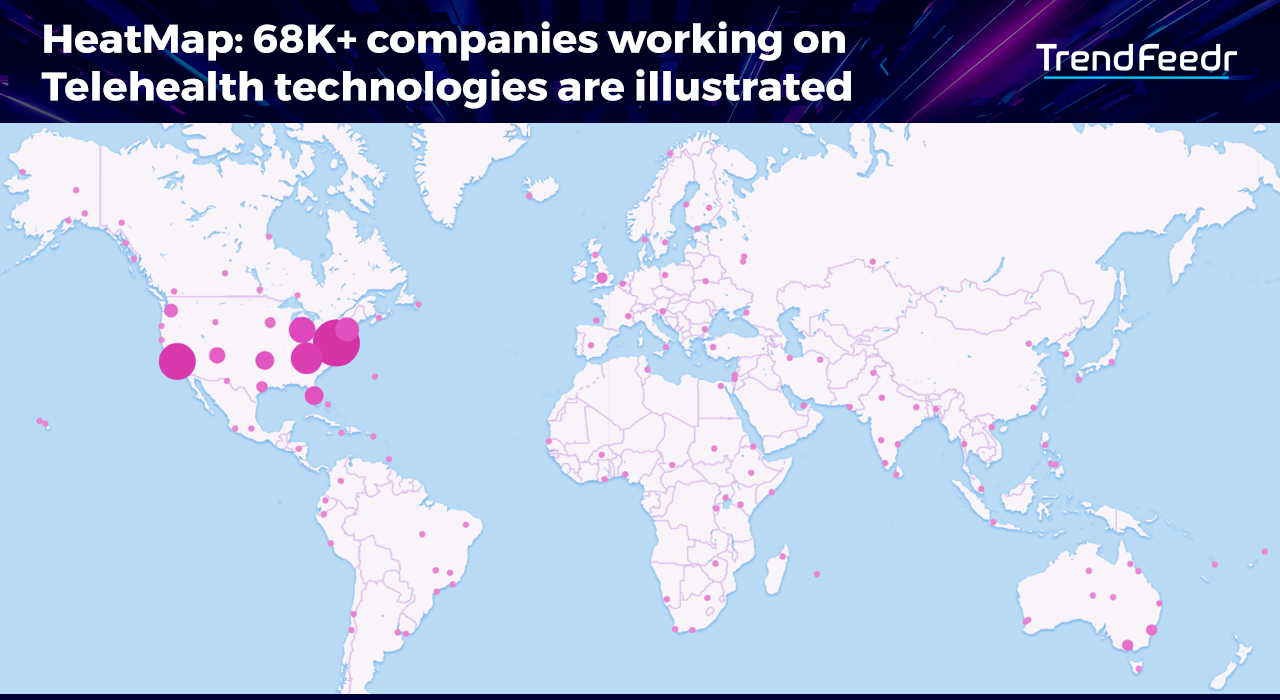Due to the pandemic, CDC reports indicated a surge in telehealth visits by 154% in the last week of March 2020, compared to the same period in 2019. In the post-pandemic era, telehealth usage has stabilized at rates 38 times higher than pre-pandemic levels. This underscores a dramatic shift in the healthcare landscape, emphasizing the importance for both healthcare providers and patients to stay updated with telehealth trends.
Understanding these trends allows businesses to keep pace with technological advancements, and anticipate market dynamics, consumer behavior, and even regulatory shifts. In this data-driven analysis, we delve into the latest trends in telehealth, including remote patient monitoring, chronic care management, HIPAA compliance, AI integration in telehealth, and mental health teletherapy.
Key Takeaways
- Dominance of Telehealth: With a trend magnitude of 99.51%, telehealth is revolutionizing healthcare delivery and patient experience.
- Diverse Emerging Trends: Entities in the telehealth realm are expanding their focus into trends, such as remote patient monitoring, chronic care management, HIPAA compliance, AI integration in telehealth, and mental health teletherapy.
- Rising Media Visibility: There has been an impressive yearly growth of 8.59% in telehealth news coverage over the last decade, highlighting its increasing importance in the global healthcare discourse.
- Substantial Backing: With 68.9K companies involved and total funding exceeding US$263.5 billion, telehealth is backed by serious financial and human resources.
- Major investors like General Atlantic, General Catalyst, and New Enterprise Associates have substantially invested in telehealth projects, reinforcing the trend’s long-term viability.
- Global Leaders in Telehealth: The United States, India, Canada, Australia, and Germany are at the forefront of telehealth initiatives, while cities like New York City, London, San Francisco, Sydney, and Melbourne stand out for their significant activity.
Table of Contents
- Understanding Telehealth Trends
- Telehealth Performance Analysis: The Future of Digital Healthcare
- Top Telehealth Trends & How Companies are Pioneering Advancements
- Telehealth’s impact Across Industries
- Telehealth Investment Trends
- The Global Adoption of Telehealth Innovations
- Future Outlook of Telehealth
We leverage TrendFeedr, our all-in-one trend intelligence platform for this comprehensive analysis of telehealth trends. TrendFeedr identifies future industry and tech trends via advanced, proprietary algorithms. With a focus on trend discovery, clustering, and analysis, the AI-powered platform screens thousands of trends each week to track their development and curate actionable insights.
Among the 20K+ trends and technologies monitored by TrendFeedr, telehealth has made a significant impact. Here’s why:
- Telehealth ranks in the top 0.46% of global trends, underscoring its rapidly growing importance in the healthcare sector.
- With a magnitude of 99.51%, telehealth is becoming an integral part of the healthcare infrastructure. It is improving access to healthcare providers and services, offering greater convenience and flexibility for scheduling visits while reducing financial burdens for patients.
- Further, the adoption of telehealth potentially reduces hospital readmissions, showcasing its efficiency and effectiveness in patient care.
In this article, we will discuss various aspects of telehealth trends including performance metrics, investment landscapes, regional adoptions, and the technologies that will shape the future of healthcare.
Understanding Telehealth Trends
Telehealth is revolutionizing healthcare delivery worldwide, making it crucial to comprehend the technological foundations driving this transformation. With that in mind, let’s dive right in.
What are the Benefits of Telehealth as a Technology Trend?
The allure of telehealth lies in its potential to democratize healthcare. This is made possible by the Internet of Things (IoT), advanced software algorithms, low-latency communication networks, and AI-driven diagnostic tools. They contribute to increased accessibility by breaking down geographical barriers and allowing healthcare providers to reach more patients, especially in remote areas. It also provides care to people with mobility limitations.
Moreover, telehealth decreases operational costs by reducing the need for physical space and passing savings on to patients and providers. IoT devices further stream patient data in real-time to enable quicker and more accurate diagnoses and treatments.
What are the Telehealth Trends for 2023 & beyond?
Virtual reality (VR) is being harnessed to provide immersive therapy sessions for conditions such as PTSD or phobias. Companies like MindMaze combine neuroscience with VR to aid patients recovering from strokes and other neurological problems.
In the realm of healthcare data security, blockchain is safeguarding sensitive patient data. For instance, MediBloc, a blockchain platform tailored for healthcare data, empowers patients with control over their own medical data while offering protection against breaches.
Additionally, artificial intelligence (AI), another telehealth trend, is making significant strides in diagnostics. It interprets medical images, predicts patient risk, and even suggests treatment options. Babylon Health is a telehealth company that offers AI-driven health services, including a chatbot that performs triage based on symptoms.
What Technologies are Behind the Telehealth Trend?
The core technologies driving the telehealth trend include secure video conferencing that ensures privacy and adheres to healthcare compliance standards. Remote patient monitoring tools measure vital statistics and relay these to healthcare providers. Further, electronic health records (EHRs) are integrated into telehealth platforms for streamlined patient care.
Telehealth Performance Analysis: The Future of Digital Healthcare
With an annual growth rate of 1.84% and a trend magnitude of 99.51%, telehealth ranks within the top 100 of over 20K+ trends, underscoring its significance. Its trend maturity at 38.37% signifies its steady assimilation into the healthcare framework.
To provide a comprehensive understanding of this rapidly evolving field, we introduce the Telehealth Trend Card. This all-encompassing snapshot offers insights into the pioneering telehealth organizations and investors driving this digital healthcare revolution. It highlights the key industries making significant strides in telehealth, the latest articles illuminating current developments, and the substantial funding being channeled into these initiatives.
You can also gain a clear understanding of the growth trajectory in this sector and see how media coverage is amplifying its impact. Our analysis offers a thorough overview of the telehealth landscape, positioning you at the cutting edge of healthcare’s digital evolution.
Looking for all trends related to telehealth?
Top Telehealth Trends & Companies Paving the Way
An estimated 68K+ organizations are investing in telehealth and branching out into related trends. Let’s explore some of these key trends that are influencing the telehealth landscape.
Remote Patient Monitoring (RPM)
- RPM enables healthcare professionals to track patients’ health data remotely.
- A total of 1988 pioneering organizations have ventured into this field, collectively raising an impressive US$10.9B in funding.
- With a dedicated team of over 127.2K individuals, these organizations are ensuring continuous, high-quality care for patients.
Chronic Care Management
- This trend focuses on providing consistent care to patients with chronic diseases.
- Chronic care management is being pursued by 1437 organizations, which have garnered a remarkable US$8.6B in funding.
- A team of 144K individuals underscores the importance of long-term patient care in the telehealth sphere.
HIPAA Compliance
- HIPAA Compliance plays a vital role in telehealth by ensuring the security and confidentiality of patient data.
- This trend is adhered to by 2123 organizations, attracting US$6.1B in funding.
- A dedicated workforce of 107.5K individuals highlights the critical importance of patient data security.
AI in Telehealth
- AI is revolutionizing telehealth by enabling smarter diagnostics and predictive patient care.
- A total of 103 organizations have embraced this trend, amassing a funding of US$455.9 million.
- A strong team of 5071 professionals is driving this transformation.
Mental Health Teletherapy
- Telehealth platforms are making mental health support more accessible through remote therapy sessions.
- Currently, 60 organizations are leading this initiative with a funding of US$339.45 million.
- A dedicated workforce of 3367 professionals is making mental well-being a click away.
Telehealth, fueled by tech advancements and the need for accessible care, is swiftly reshaping healthcare. Numerous organizations are investing in telehealth, paving the way for an inclusive, efficient, patient-centered future.
The Influence of Telehealth Across Various Sectors
The trends in telehealth are not just revolutionizing the healthcare landscape, it is transforming various industries. Let’s explore the top five industries among them:
Hospitals & Healthcare
Telehealth technologies are increasingly adopted in hospitals and generally in the healthcare industry for remote patient monitoring, virtual consultations, and even remote surgeries. Companies like Mayo Clinic are utilizing telehealth for various specializations, from neurology to cardiology. Another example – ChroniSense designs Polso which captures the radial artery signals in the wrist for remote patient monitoring.
Wellness & Fitness Services
Telehealth is used for remote consultations related to nutrition, fitness, and mental well-being. Companies, such as Amwell, are focusing on providing telehealth-based nutrition counseling, while Headspace Health offers meditation and mental health services via its platform. These solutions enhance accessibility, affordability, engagement, and outcomes for users. This makes wellness and fitness services more personalized and convenient.
Insurance
In the insurance industry, telehealth is being used to streamline the claims process by quickly verifying medical conditions and treatments. For instance, Oscar, a health insurance startup, offers Virtual Urgent Care that allows members to talk to a provider, without needing an appointment. This allows them to get diagnoses, new prescriptions, or refills quickly. The immediate consultations minimize the need for in-person visits for smaller issues.
Pharmaceuticals
Companies benefit from telehealth through remote clinical trials and patient monitoring in the pharmaceutical industry. Science 37 is a company that leverages telehealth to decentralize clinical trials, making them more patient-friendly and efficient. This accelerates the pace of clinical research and also improves its quality by reaching out to a diverse patient population. Consequently, telehealth improves patient enrollment and makes trials more inclusive.
Education
In the education sector, telehealth improves medical education by delivering remote training and real-world case studies to medical students. Platforms, such as i-Human Patients by Kaplan, utilize telehealth technologies to facilitate virtual patient interactions, thereby enhancing the clinical reasoning skills of students. This allows students to engage in repeatable clinical patient encounters in a safe environment.
As advancements in telehealth platforms continue, they streamline healthcare procedures across industries, making them more accessible, efficient, and patient-centric.
Entities Leading the Telehealth Revolution
The TrendFeedr time series chart shows a consistent 2.16% annual rise in new organizations venturing into telehealth over the past two decades. A noteworthy observation is the peak in 2020, largely driven by the global COVID-19 pandemic. It necessitated a rapid pivot to remote healthcare solutions.
Telehealth startups, many having their own telehealth app, are leading the way in revolutionizing healthcare delivery and addressing accessibility and cost issues. Here are some notable ones from the last five years shaping the future of digital healthcare.
- Vital Chat: An operator of a hands-free virtual nursing platform that enhances provider retention and patient health outcomes. Their inpatient telehealth technology integrates with partner systems, providing scalable and affordable care.
- MEDvidi: A developer of a digital mental healthcare platform that houses a team of skilled professionals. They specialize in treating a range of emotional and mental issues, including ADHD, anxiety, depression, stress, OCD, and insomnia.
- DoctorsHello: A startup that offers a medical ecosystem that promotes collaboration and information sharing. It features secure telemedicine and real-time medical video sessions.
- WITHmyDOC: An operator of a telehealth technology platform that integrates devices to offer home telehealth monitoring services tailored to various disease conditions, enabling remote patient monitoring.
- Omgyno: An online health and wellness service provider focusing on women’s healthcare challenges. Its telemedicine platform covers numerous specialties in female health, offering an alternative to traditional gynecology.
Further, the telehealth sector’s workforce is noteworthy, employing 6.8 million people, with companies averaging 127 employees and a median of 20. This reflects the sector’s scalability and diverse company sizes. The sector also adds around 454.3K jobs annually, averaging 10 new employees per company and a median of 3, indicating robust and steady growth.
Telehealth Investment Trends
In terms of financial support, telehealth’s total funding places it within the top 5% of all 20K+ trends and technologies covered by TrendFeedr.
Coming to historical financial growth, the telehealth sector has seen a consistent funding growth rate of 4.32% annually over the last 20 years. Also, the year 2020 saw a heightened investment interest amid the COVID-19 pandemic, aligning with the pressing need for remote healthcare services.
A Deep Dive into Financial Figures
TrendFeedr data reveals telehealth funding totals US$263.5 billion, with an average round of US$26.1 million and a median of US$1.6 million. The highest funding for a single company stands at US$1.3 billion in Ramsay Sime Darby. This significant financial involvement boosts the confidence of potential investors and innovators.
In terms of revenue, the sector is estimated to be worth US$1 trillion. Among the companies in this sector, BlueCare has the highest revenue, amounting to US$1.2 billion. On average, companies in the industry have a revenue of US$19 million, with a median of US$3.2 million.
Telehealth companies, responding to emerging telehealth market trends, demonstrate agility in funding diversity, utilizing various capital sources for growth and innovation. Seed funding allows telehealth startups to develop functional prototypes from promising concepts. Early-stage VC or series A funding helps refine services and initiate healthcare market penetration.
Accelerator and incubator programs offer capital, mentorship, and resources, helping telehealth companies overcome early operational challenges. Venture rounds are common among companies demonstrating market viability and aiming for rapid scaling. Lastly, telehealth grant funding addresses critical healthcare challenges, playing a unique role. Notably, 2.54% of telehealth companies have received a total of 2587 grants.
Spotlight on Key Investors
Public investments are a dominant force in telehealth – committing a remarkable US$4.1 billion across 70 enterprises. Thai Life, in particular, received US$937 million in funding.
General Atlantic follows, having invested US$2.3 billion in 17 promising companies, with the largest investment in Doctolib of US$714.9 million. General Catalyst is close behind with a total investment of US$1.9 billion across 29 companies. Its strategic investments include Ro, which received a notable US$703.1 million. New Enterprise Associates completes our list with a total investment of US$1.7 billion across 17 companies. Its portfolio highlights include Bright Health Group, receiving US$1.1 billion, and Collective Health, backed by a respectable $142 million.
The diversity of backers is also remarkable, with the number of unique investors in telehealth ranking among the top 5% across all trends.
The Global Adoption of Telehealth Innovations
The following Heat Map illustrates the worldwide distribution of 68.9K healthcare providers leading the charge in telehealth service advancements.
Interested to explore all 68K+ telehealth companies?
Certain countries are leading the way with innovation, adoption, and expansion of telehealth services. The United States stands out, with many startups, established companies, and hospitals integrating telehealth solutions into their operations. India is also making strides by leveraging its extensive IT infrastructure to facilitate healthcare access in both urban and rural areas.
Canada, with its vast geographical expanse, is using telehealth to connect remote areas to metropolitan medical hubs. Australia is pushing boundaries in telehealth adoption, particularly in outback regions. Germany, as Europe’s largest economy, is investing significant resources into telehealth infrastructure, combining its medical expertise with technological advances.
On a city-level analysis, New York City emerges as a hub for telehealth enterprises, with numerous startups and established firms focusing on remote healthcare solutions. London is quickly integrating telehealth as an essential service with its advanced healthcare system. San Francisco is also making progress in telehealth innovation, particularly in merging AI and IoT with remote healthcare. Sydney and Melbourne are offering state-of-the-art solutions to both their urban population and more isolated regions of the country.
Telehealth Media Coverage Increased by 8.59% Yearly Over Two Decades
The spotlight on telehealth in the media landscape has significantly amplified over the years. Our line chart demonstrates a strong annual growth rate of 8.59% in telehealth news coverage over the past two decades. Interestingly, there was a distinct peak in 2020, corresponding to the COVID-19 outbreak which brought telehealth to the forefront of healthcare discussions.
In terms of volume, a remarkable 35,496 articles focusing on telehealth have been published between 2006 and 2023. This extensive coverage catapults telehealth into the top tier, placing it within the top 5% of over 20,000 trends analyzed by TrendFeedr.
However, this media attention is more than just a numbers game; it’s symbolic. It highlights the crucial role of telehealth in transforming the accessibility, delivery, and perception of healthcare, reaffirming its potential to reshape healthcare paradigms for the foreseeable future.
Future Outlook of Telehealth
At the crossroads of cutting-edge technology and enhanced healthcare delivery, telehealth is set for exponential growth and transformation. Here is a glance into the pivotal factors shaping future telehealth trends.
1. IoT Device Integration
The emphasis on telehealth necessitates advanced remote monitoring and real-time data collection. IoT devices will increasingly facilitate this, with wearables, smart home devices, and specialized medical equipment contributing to a dynamic healthcare landscape.
2. Broadening Mental Health Services
The rising global concern for mental health issues demands an expansion of telehealth services. More companies will consider including mental health consultations and therapies in their telehealth offerings.
3. Revolutionizing Diagnostics with AI and Machine Learning
AI and machine learning are set to transform diagnostic processes within telehealth platforms. These technologies will analyze large datasets, providing predictive insights and accurate diagnoses for proactive healthcare solutions.
4. Strengthened Government Regulations and Policies
The telehealth industry is likely to face challenges from new regulations and policies introduced globally. These could range from data protection laws to guidelines around telehealth reimbursements.
5. Improving Patient Experience
With the maturation of telehealth technologies, the focus will shift toward enhancing the overall patient experience. Aspects like user-friendly interfaces, multi-language support, and personalized healthcare plans will be critical for customer retention and brand value.
As telehealth reshapes the healthcare landscape, it will become crucial for stakeholders to stay proactive, adaptable, and patient-focused to ensure its promising future.
How to Stay Updated with the Progressions in the Telehealth Landscape?
Telehealth is an ever-evolving field, with insights and advancements regularly surfacing. Data suggests a promising future for telehealth, propelled by continuous technological and medical innovations while making distance irrelevant in healthcare delivery.
Staying informed is crucial to align your healthcare strategies with this dynamic sector. How can you achieve this? Delve into specialized telehealth journals, participate in digital communities specific to the sector, seek advice from telehealth trailblazers, and attend online healthcare summits and seminars. A trend intelligence platform like TrendFeedr offers valuable insights into emerging telehealth trends.
By staying up-to-date on the latest telehealth developments, you can make strategic decisions that resonate with the shifting paradigms of the healthcare landscape.








